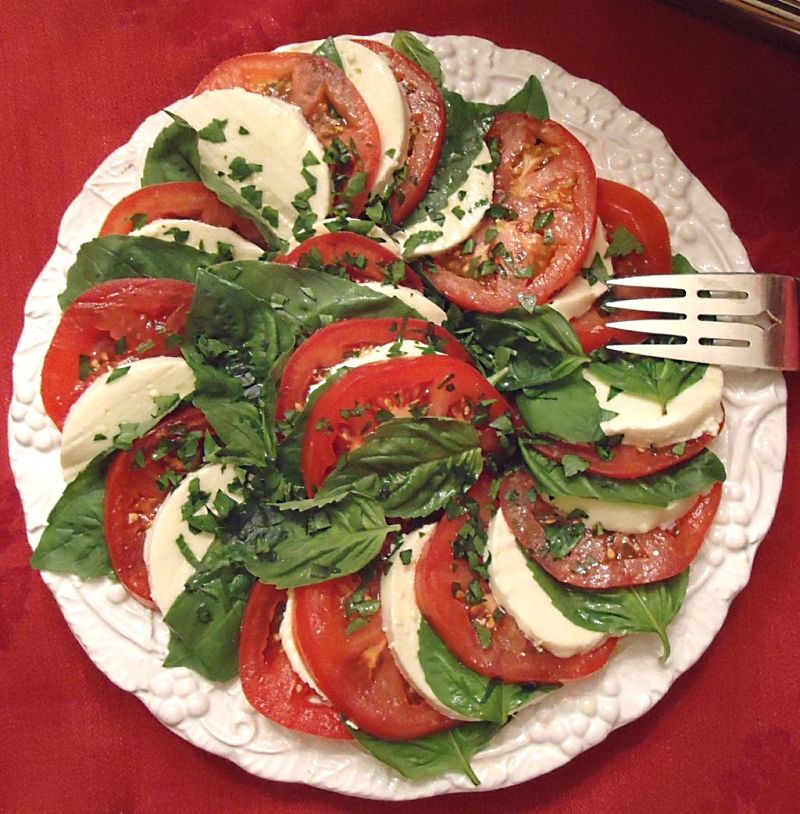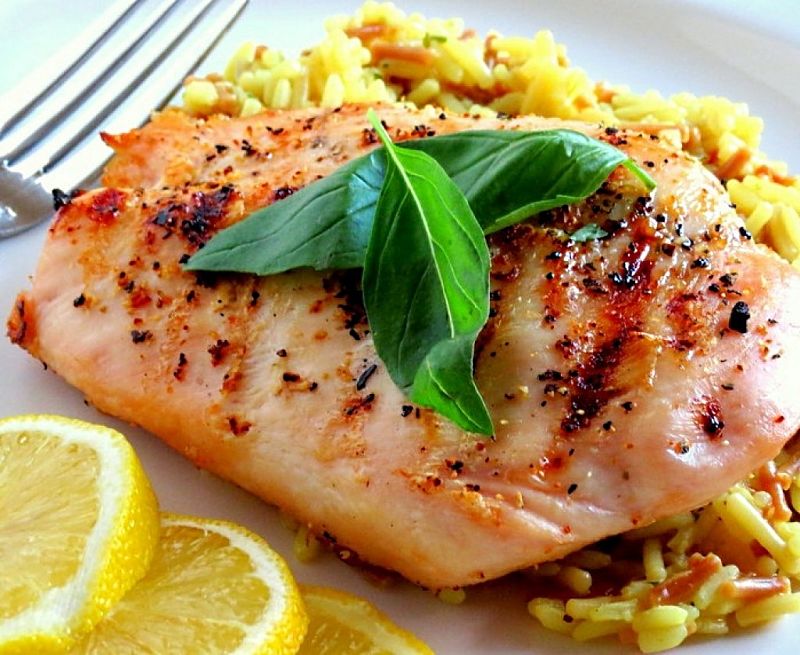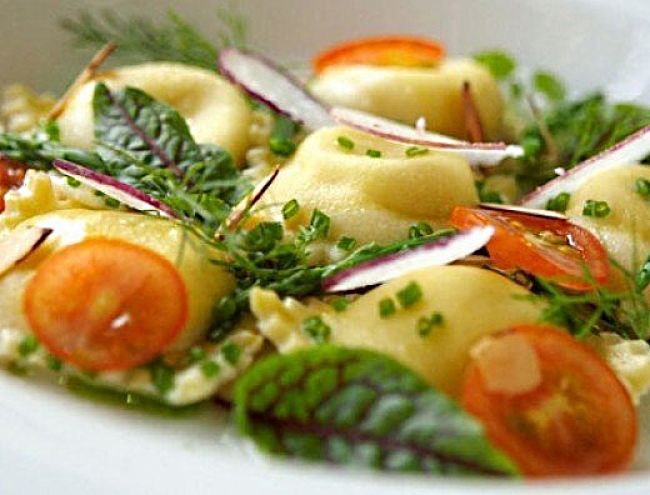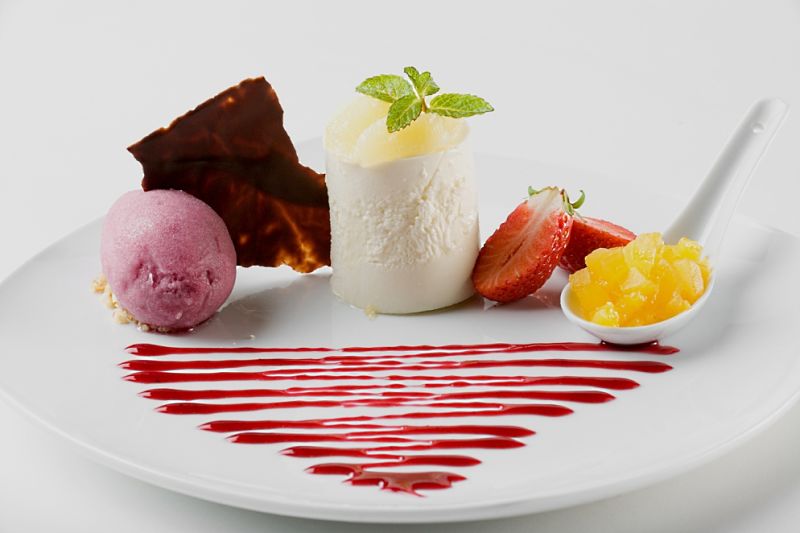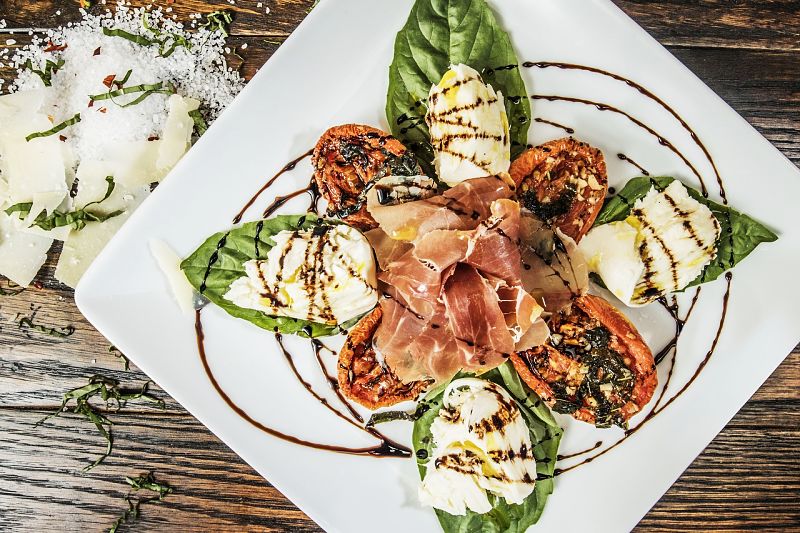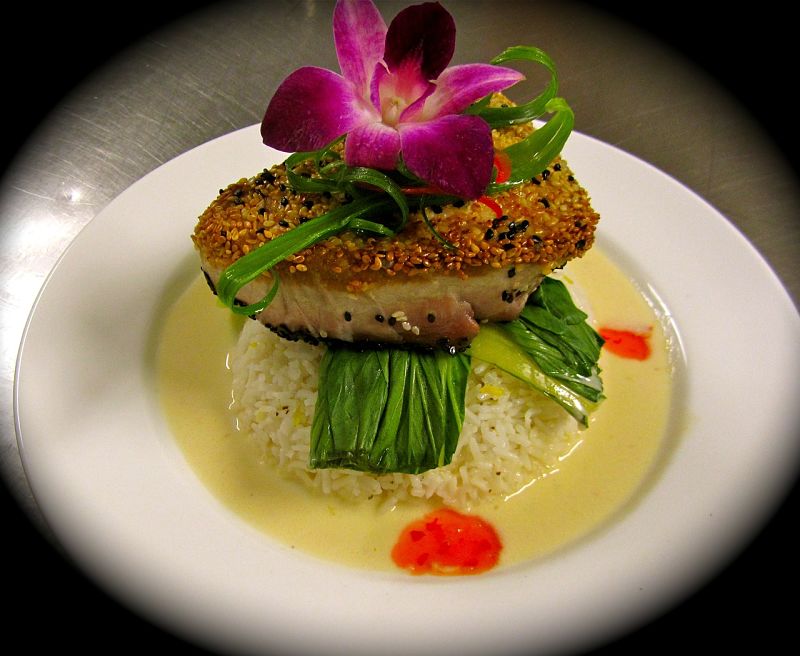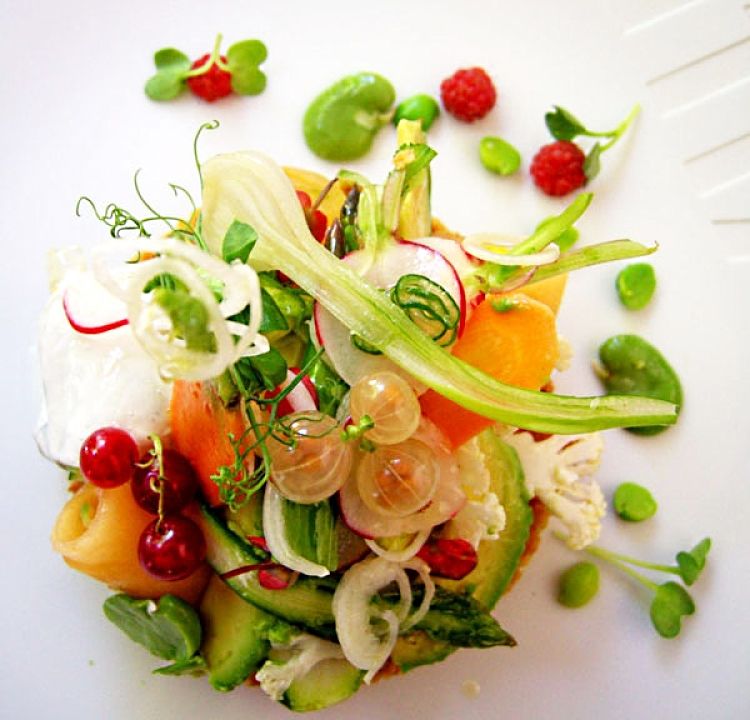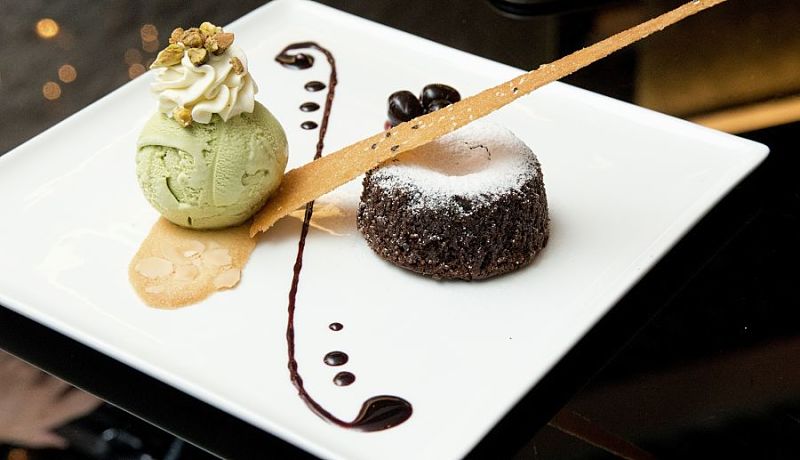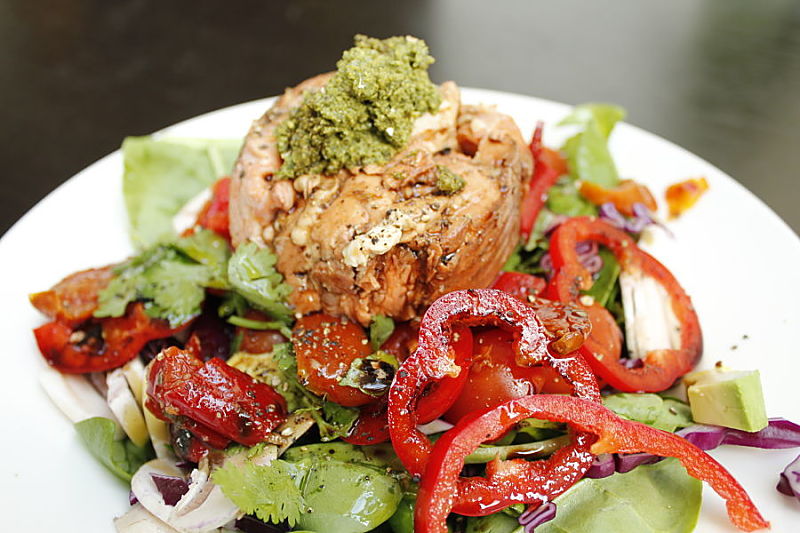Food Presentation Tips and Guides - How to Plate and Garnish Food for Serving
Good and effective food presentation is essential when serving any meal as it enhances the appeal of the food and stimulates the appetite. Food that looks good, always tastes better.
After the dish is cooked 'the die is cast' in terms of its color, texture, taste and basic visual appeal, but you can always add something extra to the plate in a decorative way and add garnishes and decorations that will help the dish look good and more appetizing.
Small things really matter, especially for dinner parties but also for family meals. You can add interest and variety by being creative in making common family meals such as pasta with sauce, a lot more attractive.
There is a lot to learn about the art and science of how to plate and garnish food on the canvas of the plate.
This article describes how you can improve the appeal of a dish on a plate through applying some simple tips for presentation and garnishing.
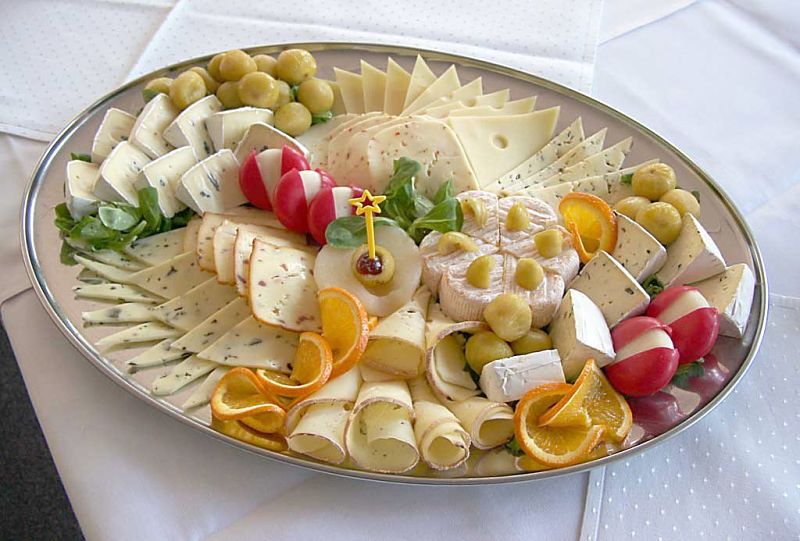
The Plate as a Canvas
Think of the plate as a canvas for a work of art such as for a painting or drawing. Sight and smell are major sensors that add to the taste and enjoyment of any meal and good presentation enhances this. Just as for a painting you should aim for a balanced composition with as much depth as possible. Pay particular attention to the flow, colors, the patterns and the lines as you add food to the plate. The techniques used for photographing food are also relevant.
Why Small Portions on a Plate with a Large Perimeter Works
One simple trick is to mimic upmarket restaurants, who present food with a 3-dimension perspective and with a relatively wide empty perimeter around the food. Using a largish plate size for the size of the serving, with a small central area for holding the food, but a relatively wide rim makes the serving appear larger and much more attractive. The aim is not to hide the fact that the servings are small, but to provide the best presentation for the dish. But don't overdo the plate size. Using appetizer plates instead of larger main course plates for relatively small servings can stop the impression of being miserly. If the serving is small use a smaller plate - it is a matter of balance. Try to use plate with wider rims for a plate balanced for the serving size.
Plate Colors and Styles Do Matter
Once again emulate the large restaurants in choosing stylish plates (square or round) of the right color and shape for the food you are serving. The color of the plate itself is important and should match the dish being served in terms of color balance. Plain white is a good option but also consider black and other stylish colors and patterns. Of course, you may be limited in the range of plates you have at home, but consider buying a new set so you have options for different types of food. This also adds variety.
Other simple things to try are slicing a small serving of an expensive cut of meat so that it fans out to covering more area on the plate, making the portion appear larger. Stacking food also makes it appear more exciting and appealing, by adding a third dimension. Being generous with accompaniments such as vegetables that are bright, lush and in season can help to make a small meat portion look larger and can add bulk to the meal without adding extra calories.
Why Food Should Be Presented in a Fun Way
We eat with our eyes and so color, appearance and texture are just as important as taste, and smell is very important as well as it is a crucial part of taste. So have fun with the presentation of food. This especially applies for kids meals but adults also enjoy something innovative and different as well as they are grown-up kids at heart. Even the tried-and-true kids' favorites such as macaroni and cheese, can be made lots more attractive and healthy by adding various decorations and garnishes in the form of slivers of yellow, green and red peppers, shaped into flowers, twirls and other shapes (the kids may even eat them!).
Top Tips for Food Presentation that Work Well
Serve the food on plain plates, white or colored
White plates seem to work well with most types of food, but not all, so consider the type of dish and the colour of the food you are serving. You may not have a vast array of crockery, but some simple ideas can work very well. Consider what sort of plates you are missing and how to update your crockery to suit the dishes that you cook for your next purpose. Always try to match the plate color to the type and style of food. A tortilla filled with prawns and coriander would look much better and delicious on a terracotta plate, a slice of dark chocolate torte would looks startling on a white. Square plates work well with heavy meat dishes when you can pile things up in the centre of the plate and add the vegetables in an unsymmetrical way.
Size of plate
Consider the size of the portion that you are going to serve and the impression you want to create with it before choosing the plates to serve it on. A small serving of an expensive and specially cooked piece of meat of fish can give the impression of 'rarity' and uniqueness when presented on a large plate. On other occasions you may want to display abundance or fullness with a serving of a meat casserole. A small serving of cake can appear huge on a small plate especially when the cake piece is relatively tall. The general rule of thumb is to use a plate that matches the size of the dish. However try to use plates with a broad rim or outer perimeter that creates a more dramatic look.
Clean surrounds for presentation
Make sure that your plates are scrupulously clean and dry. Rinse the plates under hot water and dry them with a clean tea towel. Carefully add the food without leaving any food trails and spots apart from your deliberate drizzles and swirls. Always wipe off any spills or residues. Clean surrounds make a tremendous difference to the appearance of food on the plate. The food will taste better as well.
Make the Main Part of the Dish most Prominent
Make sure that the main part of your dish is presented at the front of the plate. Place any garnishes or accompaniments such as vegetables to the side or at the back of the plate so that they don’t steal the show. Leave off any food items that may distract from the impact of how the main feature looks. Consider serving vegetables and salads as a side dish.
Garnishes
Keep garnishes delicate, nice, colorful, interesting and simple. Make sure that they are well related to the food that they are accompanying and that the colors compliment it. Garnishes are all about texture, color, shape, taste and intrigue A simple sprig of fresh coriander can enliven a creamy bowl of chicken curry or a Thai soup. Always ensure the garnishes are fresh and lively and plate them just before serving. Don't overdo the garnishes as this destroys the impact.
To Serve on Plates or Not to Serve
Some dishes look great presented on a plate, whereas other food looks and works so much better served whole in a central serving bowl with other items such as salad or vegetables served on the plate. A good example of this is lasagne or risotto – looks golden and steaming straight out of the oven, but can be a bit of a mess when served on a plate as a portion.
Sauces
Place all your food into position on the plate, including garnishes before you pour on the sauce. Think carefully about where you want the sauce to go and how it will flow. You only have one chance at this so be patient and get it right. Pour slowly and add a little at a time to see where it will flow. If in doubt add the sauce as a side dish.
Use a Standard 'Clock' based Layout with the Types of Food Grouped
One simple way to place food on a plate is to place the meat at "6 o’clock", from the diner’s perspective, the carbohydrate (rice, potatoes, pasta, etc.) at "11 o’clock," and the vegetables at “2 o’clock,” Generally the vegetables should cover about half of the plate.
Be Adventurous and Try Odd Numbers of Items
It is odd, but food items on a plate generally look more interesting when there are odd numbers of them. So when serving mushrooms, put five on each plate, rather than four or six.
Play with Height and the Third Dimension
This does not necessarily only apply to the main item. For example presenting high mound of rice next to a stir-fry can add interest. If you have a hill of mashed potatoes on the plate, you can try leaning your pork chop against it or the asparagus spears so that these items are orientated vertically. Or you can stack various items, for example putting sliced grilled chicken pieces on top of a mound of rice. But don't overdo it or it will look silly!
Experiment with Color and Texture
Look to add colors to brighten up the presentation, such as green paper napkins, red such tomatoes or red peppers, yellow and green capsicum pieces. Similarly, mix up the texture in how the dish appears. If you serve a flat piece of steak top it with some walnuts, coriander or(crumbly) feta cheese. Add something to break up the flatness of any dish.
Garnish Appropriately and with Style
Match the garnish with the recipe. Any garnishes added to the plate should be colorful, add texture to the dish and generally be edible to enhance the flavor of the main dish. But don't overdo the garnishes especially when the ingredients are not fresh. Redundant and extremely fancy garnishes such as flowers cut from radishes have generally gone out of favor.
Add gloss
To add gloss mix a light sugar syrup made by combining one part sugar to one part. You can infuse the water with citrus or a vanilla bean to add flavor. A circle of gloss can be added around a plated dessert to add polish.
Additional Hints
- Mix vegetables, salad greens and noodles in a bowl with dressing or oil before adding them to a plate. This ensures these items are well mixed and coated with the dressing and avoids spreading the dressing everywhere.
- A small plastic squeeze bottle (with a small hole) is ideal for applying olive oil and vinegars.
- To make a beautiful pile of spaghetti, twirl the plate when you serve it.
For thick sauces use a spoon to serve it out and for thinner sauces use a ladle. It is generally better to add the sauce after plating the dish. - Don’t overload the plate or use a plate size that is too small.
- Keep the rim of the plate clear of both garnishes and the food and always remember to wipe the perimeter clean of any dribbles.
- If you have to leave food sitting idle before serving it, drizzle a little flavored oil or extra virgin oil over meat and vegetables before serving to add flavor, freshness and gloss.
- Prepare salads as side dishes by starting with the heaviest ingredients as a foundation and adding the lighter ingredients on top.
- Place dessert plates in the freezer for several minutes before plating desserts to prevent whipped cream or ice cream from melting or sliding around when you are trying to arrange things on the plates.
